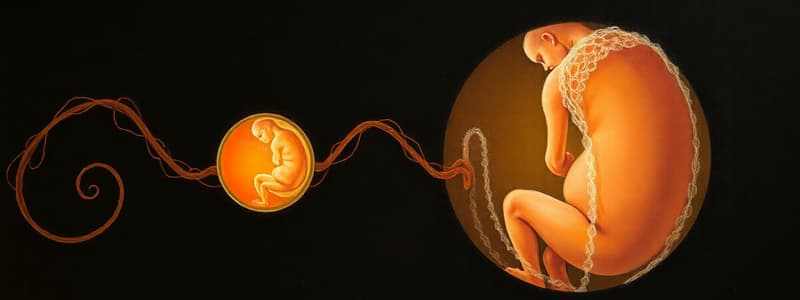Podcast
Questions and Answers
What is superfecundation?
What is superfecundation?
- Fertilization of a single ovum during different menstrual cycles
- Fertilization of multiple ova by sperms from separate acts of coitus (correct)
- Fertilization that occurs outside the uterine cavity
- Fertilization of multiple ova by the same sperm during one act
What characterizes the morula stage?
What characterizes the morula stage?
- Consists of 8 cells and enters the uterine cavity
- Consists of 16 to 32 cells and is formed 3 days after fertilization (correct)
- Is the last stage before implantation occurs
- Contains a blastocoele filled with fluid
During which stage does the blastocyst begin to form?
During which stage does the blastocyst begin to form?
- 4 days after fertilization (correct)
- At the morula stage
- Immediately after fertilization
- 2 days after fertilization
What is the function of the trophoblast in the blastocyst?
What is the function of the trophoblast in the blastocyst?
What occurs during the cleavage or segmentation process?
What occurs during the cleavage or segmentation process?
What is the site of fertilization in human reproduction?
What is the site of fertilization in human reproduction?
What is the purpose of capacitation in sperm?
What is the purpose of capacitation in sperm?
Which enzyme helps sperm penetrate the corona radiata during fertilization?
Which enzyme helps sperm penetrate the corona radiata during fertilization?
What reaction occurs to prevent polyspermy after fertilization?
What reaction occurs to prevent polyspermy after fertilization?
What event follows the fusion of oocyte and sperm plasma membranes?
What event follows the fusion of oocyte and sperm plasma membranes?
What type of anomaly involves being pregnant without fertilization?
What type of anomaly involves being pregnant without fertilization?
What determines the sex of the embryo?
What determines the sex of the embryo?
What is the chromosomal configuration of a zygote?
What is the chromosomal configuration of a zygote?
Flashcards
Fertilization
Fertilization
The joining of male and female gametes (sperm and egg).
Site of Fertilization
Site of Fertilization
The ampulla of the uterine tube.
Capacitation
Capacitation
The process of sperm activation in the female reproductive tract.
Acrosomal Reaction
Acrosomal Reaction
Signup and view all the flashcards
Zona Pellucida
Zona Pellucida
Signup and view all the flashcards
Embryo Sex Determination
Embryo Sex Determination
Signup and view all the flashcards
Parthenogenesis
Parthenogenesis
Signup and view all the flashcards
Dispermy
Dispermy
Signup and view all the flashcards
Superfecundation
Superfecundation
Signup and view all the flashcards
Cleavage (Segmentation)
Cleavage (Segmentation)
Signup and view all the flashcards
Morula Stage
Morula Stage
Signup and view all the flashcards
Blastocyst Stage
Blastocyst Stage
Signup and view all the flashcards
Inner Cell Mass (Embryoblast)
Inner Cell Mass (Embryoblast)
Signup and view all the flashcards
Study Notes
Fertilization
- Definition: The union of male and female gametes
- Location: Ampulla of the uterine tube
- Steps:
- Sperm deposited in the posterior fornix of the vagina (200-600 million)
- Capacitation: Removal of proteins from sperm's head, making it more active. Happens in the female reproductive tract (5-7 hrs)
- Acrosomal reaction: Enzymes released from the acrosome of the sperm to penetrate the corona radiata and zona pellucida.
- Fusion of sperm and egg membranes
- Zona cortical reaction: Prevents polyspermy (multiple sperm fertilizing an egg)
- Second oocyte resumes meiosis, forming a female pronucleus
- Male pronucleus formation (tail lost, nucleus enlarges)
- Union of pronuclei: Formation of zygote (46 chromosomes)
First Week Results
- Sex determination: Y chromosome → male; X chromosome → female
- Health assessment of the embryo
- Resumption of meiosis II
- Restoration of normal diploid chromosomes (46)
- Initiation of zygote cell division
Anomalies
- Parthenogenesis: Embryo development without fertilization (all offspring female)
- Dispermy (triploidy): Two sperm fertilize one ovum (zygote with 3 sets of chromosomes)
- Superfecundation: Two ova are released and fertilized by sperm in the same menstrual cycle
Cleavage (Segmentation)
- Definition: Repeated mitosis of blastomeres (cells) to increase cell number within the fallopian tube
- Steps:
- 2-cell stage, 4-cell stage, 8-cell stage...etc.
- Morula stage: (16-32) cells; formed 3 days after fertilization; enters uterine cavity
- Blastocyst/Blastula stage: (4th day)
- Blastocele: Fluid-filled cavity
- Trophoblast: Outer layer of cells, forms part of placenta
- Inner cell mass (embryoblast): Mass of cells that form the embryo
Studying That Suits You
Use AI to generate personalized quizzes and flashcards to suit your learning preferences.
Related Documents
Description
This quiz covers the complex process of fertilization, including the steps from gamete union to the formation of a zygote. It also addresses key developments during the first week after fertilization, such as sex determination and chromosome restoration. Test your understanding of these fundamental concepts in human reproduction.




